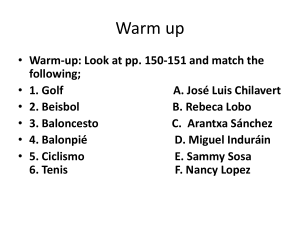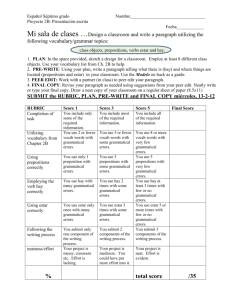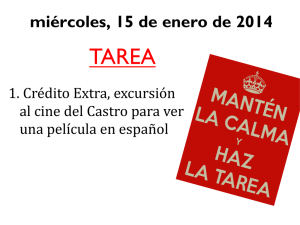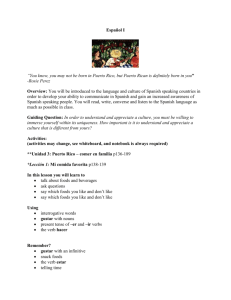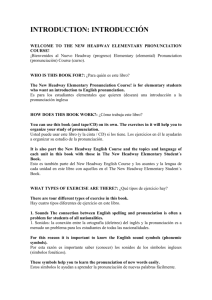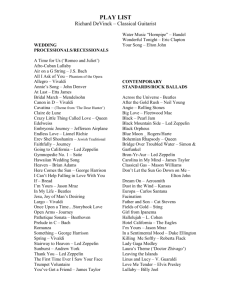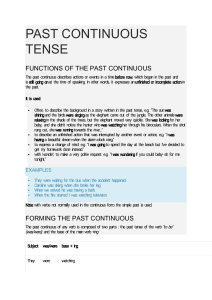Tune In To Español - Songs for Teaching
advertisement
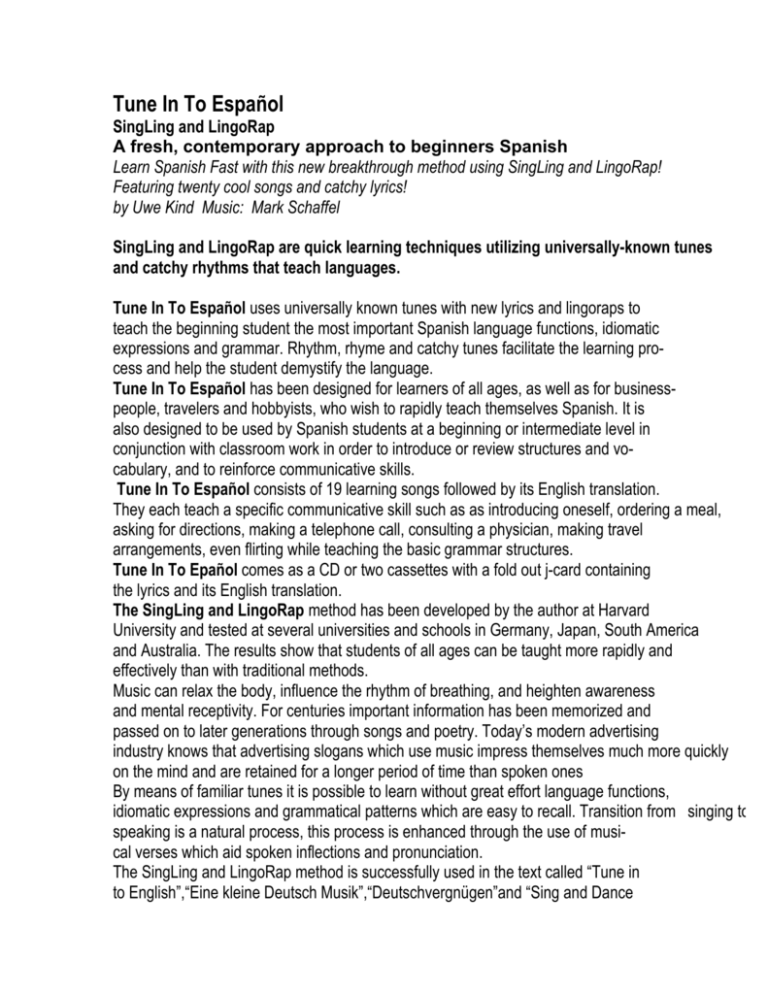
Tune In To Español SingLing and LingoRap A fresh, contemporary approach to beginners Spanish Learn Spanish Fast with this new breakthrough method using SingLing and LingoRap! Featuring twenty cool songs and catchy lyrics! by Uwe Kind Music: Mark Schaffel SingLing and LingoRap are quick learning techniques utilizing universally-known tunes and catchy rhythms that teach languages. Tune In To Español uses universally known tunes with new lyrics and lingoraps to teach the beginning student the most important Spanish language functions, idiomatic expressions and grammar. Rhythm, rhyme and catchy tunes facilitate the learning process and help the student demystify the language. Tune In To Español has been designed for learners of all ages, as well as for businesspeople, travelers and hobbyists, who wish to rapidly teach themselves Spanish. It is also designed to be used by Spanish students at a beginning or intermediate level in conjunction with classroom work in order to introduce or review structures and vocabulary, and to reinforce communicative skills. Tune In To Español consists of 19 learning songs followed by its English translation. They each teach a specific communicative skill such as as introducing oneself, ordering a meal, asking for directions, making a telephone call, consulting a physician, making travel arrangements, even flirting while teaching the basic grammar structures. Tune In To Epañol comes as a CD or two cassettes with a fold out j-card containing the lyrics and its English translation. The SingLing and LingoRap method has been developed by the author at Harvard University and tested at several universities and schools in Germany, Japan, South America and Australia. The results show that students of all ages can be taught more rapidly and effectively than with traditional methods. Music can relax the body, influence the rhythm of breathing, and heighten awareness and mental receptivity. For centuries important information has been memorized and passed on to later generations through songs and poetry. Today’s modern advertising industry knows that advertising slogans which use music impress themselves much more quickly on the mind and are retained for a longer period of time than spoken ones By means of familiar tunes it is possible to learn without great effort language functions, idiomatic expressions and grammatical patterns which are easy to recall. Transition from singing to speaking is a natural process, this process is enhanced through the use of musical verses which aid spoken inflections and pronunciation. The SingLing and LingoRap method is successfully used in the text called “Tune in to English”,“Eine kleine Deutsch Musik”,“Deutschvergnügen”and “Sing and Dance Around the World” in the United States, Europe, South America, Japan, Australia and New Zealand. To the Teacher Before you start using Tune In To Español familiarize your students with the SingLing and LingoRap method by pointing out that rhythm, rhyme and a simple or already familiar tune aid in learning and recalling.Since important elements of this method are relaxation and enjoyment, students should notbe forced to sing in front of the class or to sing aloud. Those who claim they cannot sing, or are too shy to do so, can also learn by silently singing or speaking to themselves as well as by mere listening. Tell your students that you don’t have to be an opera singer! Each song and/or rap is self-contained and deals with a particular language function which teaches useful expressions, grammar and vocabulary. Tune In To Español is intended to serve as supplementary material for your Spanish classes. You can use the songs to create a relaxed atmosphere and to introduce or review language functions or grammatical patterns at the beginning of the class. During your class it provides a bridge between different activities and introduces a change of pace. At the end of the class it ensures that you will finish on an upbeat note. The following steps can be applied for each unit.: 1. If you choose a song rather than a LingoRap from the CD, see if someone knows the tune and ask that person to hum it. 2. Describe the content of the text in simple Spanish and have the students repeat the words and expressions in the song after you. 3. Focus on the content of the song and the language function connected with it. 4. Play the CD and have the student relax while listening to it. 5. Play the song again and have the class sing or rap the entire song through several times. 6. With dialogue songs or raps divide the class into groups and have each group sing or rap the parts. Repeat the song and change roles. In the case of a narrative song or rap, have each group sing or rap a different verse. 7. Act out the song or rap through role playing. You can easily steer the situation by supplying your students with musical signals. 8. Combine songs and raps and create ‘drama series’. Index Tune In To Español Disc I (1) ¡No Comprendo! You identify yourself as a foreigner/understanding/not understanding what is said. (2) ¿Buenos días,¿cómo está? Greeting someone “How are you?” and various responses (3) ¿Cómo se dice en español? Asking someone the name of an object; asking someone the spelling of a word; identifying an object (4) Una pera y dos bananas The numbers and plural nouns; directions (5) ¿Cuánto cuesta? Negotiating a price (6) Gracias por todo Thanking someone; expressing gratitude, asking someone to pass on regards saying good bye and wishing someone a good trip. (7) El lunes estoy en Canadá Annoucing travel schedules and the days of the week (8) ¿Dónde está la terminal? Asking the way to the train station; giving directions (9) Esto me gusta Expressing likes and dislikes (10) ¿Qué hora es Maríta? Asking for the time; expressing surprise; Dis II (11) (12) ¿Podría ayudarme? Asking for help; thanking someone Conozco al señor Bosco (I know Mr. Bosco (13) (14) (15) (16) (17) (18) (19) Asking for the whereabouts of a person ¿Que tiempo hace? (What’s the weather like?) Talking about the weather. ¿Qué recomienda usted? (What can you recommend?) Selecting a meal in a restaurant; asking for the check ¿Cómo esto funciona? (How does this work?) Asking someone how to operate a pay telephone ¿Está Susana por favor? (Is Susana in?) Trying to reach someone on the telephone Hoy estoy Expressing feelings and emotions ¡Tengo dolores! (I have a pain) Consulting a physician Rico chico (Rich guy) Word and phrases that you may already know. Unit 1 ¡No comprendo! ¡Yo comprendo! (She’ll Be Coming 'Round The Mountain When She Comes) Trad. American Folk Song © 2001 Uwe Kind/Mark Schaffel Lady: Señor: Lady: Señor: I wonder where the lady’s room is. Perdon.... ¿Le puedo ayudar? ¿Dónde esta el baño? ............... ¡No comprendo español muy bien, señor! ¡No comprendo español muy bien, señor! ¡Más despacio, más despacio, más despacio, más despacio! ¡No comprendo español muy bien, señor! ¡No comprendo español muy bien, señor! ¡No comprendo español muy bien, señor! ¡Sólo hablo un poquito! ¡Sólo hablo un poquito! ¡No comprendo español muy bien, señor! ¡Yo comprendo! ¡Yo comprendo, sí, señor! ¡Yo comprendo! ¡Yo comprendo, sí, señor! ¡Yo comprendo lo que dice! ¡Yo comprendo lo que dice! ¡Yo comprendo, yo comprendo, sí, señor! ¡Yo comprendo! ¡Yo comprendo, sí, señor! ¡Yo comprendo! ¡Yo comprendo, sí señor! ¡Muchas gracias por su ayuda! ¡Muchas gracias por su ayuda! ¡Yo comprendo, yo comprendo, sí, señor! Translation ¿Le puedo ayudar? = Can you help me?; ¿Dónde esta el baño? = Where is the toilet?; ¡No comprendo español muy bien, señor! = I don’t understand Spanish very well, sir!; ¡Sólo hablo un poquito! = I only speak a little; ¡Yo comprendo, sí, señor! = I under- stand, yes, sir; ¡Yo comprendo lo que dice! = I understand what you are saying;¡Muchas gracias por su ayuda! = Thank you very much for your help; Más despacio = (Speak) slower/slowly. Buenos días, ¿cómo esta? Unit 2 (Schwäbsche Eisebahne) (Traditional German Folk Song) © 2001 Uwe Kind/Mark Schaffel Daniela loves the circus. She decides to pay the circus a visit. She sneaks backstage and spies the clown practicing his tap dance act before the upcoming performance. She decides to start a conversation with him. !Escuche! Daniela: José: Buenos días, ¿cómo está? Buenos días, ¿cómo está? Buenos días, ¿cómo está? Muy bien, muchas gracias. José: Daniela: José: Daniela: José: Daniela: José: Daniela: ¿Cómo está? Muy bien, muy bien. ¿Cómo está? Muy bien, muy bien. ¿Cómo está? Muy bien, muy bien. ¿Cómo está? Muy bien, muy bien. Daniela: José: Daniela: José: Daniela: José Daniela: ¿Cómo está? Así, así. ¿Cómo está? Así, así. ¿Cómo está? Así, así. ¿Cómo está? José Así, así. Daniela: José: Buenos días, ¿cómo está? (3x) Muy bien, muchas gracias. Daniela: José: Daniela: José: Daniela: José ¿Cómo está? Muy, muy cansado. ¿Cómo está? Muy, muy cansado. Y, ¿por qué, por qué, José? ¡Ay, ay, ay, no se, no sé! Translation ¡Escuche! = Listen! Buenos días, ¿cómo está? = Hello, how are you?; Muy bien, muchas gracias. = Very well, thank you; Así, así = so, so; Y, ¿por qué? = And why? ;No sé . = I don’t know ; muy, muy cansado = very, very tired Unit 3 ¿Cómo se dice en español? (Who's in the kitchen with Dina?) (Trad. American Folksong) © 2001 Uwe Kind/Mark Schaffel How do you say “how do you say ‘this’” in Spanish? How do you say “how do you write ‘this’” in Spanish? How do you say “what is this’” in Spanish? Listen as Pedro Pregunta gives his friend Cara Como a little Spanish lesson. Cara Como: Pedro Pregunta: Cara Como: Pedro Pregunta: ¿Cómo se dice en español? Se dice, se dice "caracol" ¿Cómo se dice en español? Se dice, se dice "caracol" (2x) Cara Como: Pedro Pregunta: Cara Como: Pedro Pregunta: ¿Cómo se escribe "caracol"? “C-A-R-A-C-O-L” ¿Cómo se escribe "caracol"? “C-A-R-A-C-O-L” (2x) Cara Como: Pedro Pregunta: ¿Qué es esto? Una pastilla. Cara Como: Pedro Pregunta: Cara Como: Pedro Pregunta: Cara Como: Pedro Pregunta: Cara Como: Pedro Pregunta: Cara Como: Pedro Pregunta: ¿Qué es esto? Una tortilla. ¿Es la tortilla para mí? Claro, si, es para tí. ¿Qué es ésto? Limonada. ¿Qué es esto? Ensalada. ¿Es la ensalada para mí? No es para tí. Es para mí. (2x) (2x) Translation: ¿Cómo se dice en español? = How do you say in Spanish?; Se dice "caracol" = You say “caracol”; el caracol = the snail; ¿Cómo se escribe “caracol”? = How do you write “caracol”?; español = Spanish; ¿Qué es esto? = What is this?; una pastilla = a pill; una tortilla = a tortilla (flat bread made of corn); Es la tortilla para mí? = Is this tortilla for me?; claro = of course; para tí = for you (fam); limonada = lemonade; ensalada = salad Una pera y dos bananas Unit 4 (Mambo) © 2001 Uwe Kind/Mark Schaffel This song is called “Una pera y dos bananas“ one pear and two bananas. It will teach you the Spanish numbers, plural nouns and a few expressions. Una pera, dos bananas, tres tortugas, tres manzanas, Refrain: cuatro cuadros cinco días, seis semanas, seis tortillas (repeat) una pera y dos bananas una pera y dos bananas arriba, arriba, a la derecha abajo, abajo, a la izquierda arriba, arriba, a la derecha abajo, abajo, a la izquierda cinco sellos, seis semanas, ocho ríos, nueve ranas, Refrain: diez calles, veinte villas treinta tías cuarenta días, (repeat) una pera y do bananas........ sesenta gatos, ochenta pesos, noventa platos, y cien besos. sesenta gatos, ochenta pesos, noventa platos, y cien besos. Translation: Una pera = a pear; dos bananas = two bananas; tres tortugas = three turtles; tres manzanas = three apples; cuatro cuadros = four pictures; cinco días = five days; seis semanas = six weeks; seis tortillas = six tortillas; cinco sellos = six stamps; ochos ríos = eight rivers; nueve ranas = nine frogs; diez calles = ten streets; veinte villas = twenty small towns; treinta tías = thirty aunts; cuarenta días = fourty days; sesenta gatos = sixty cats; ochenta pesos = eighty pesos; noventa platos = ninety plates/dishes; y cien besos = and one hundred kisses; arriba = above/on top/upstairs; a la derecha = to the right; abajo = down/below/underneath; a la izquierda = to the left ¿Cuánto cuesta? LingoRap © 2001 Uwe Kind/Mark Schaffel Unit 5 Do you like to haggle? Do you like to negotiate? Do you like to get a bargain? If you do, then this song may save you a couple of pesos....or maybe not! Listen and figure out if señora gets the deal she’s looking for! Señora: ¿Cuánto cuesta, señor? ¿Cuánto sale, señor? ¿Es caro? ¿Es caro? ¿Cuánto sale, señor? Señora: ¿Cuánto cuesta, señor? ¿Cuánto sale, señor? ¡Cuarenta centavos! No es caro, señora. Vendedor: Refrain: Treinta y uno, treinta y dos, treinta y tres, treinta y cuatro, treinta y cinco, treinta y seis, treinta y siete, treinta y ocho, treinta y nueve...¿cuarenta? Señora: Es muy caro, señor. Es muy caro, señor. Es muy, muy barato. No es caro, señora. Vendedor: Vendedor: Señora: Refrain: Treinta y uno, ... Señora: Vendedor: Señora: Refrain: Es barato, señora. Es barato, señora. No puedo comprarlo Es muy caro, señor. ¡Es caro señor! ¡Es caro señor! ¡Cuarenta centavos! ¡Llevo uno por favor! Treinta y uno, ... Translation ¿Cuánto cuesta? = How much does it cost?; ¿Cuánto sale? = For how much does it sell?; ¿Es caro? = Is it expensive?; Cincuenta centavos = Fifty cents; No es caro = It is not expensive; Es muy caro = It is very expensive; barato = inexpensive; No puedo comprarlo = I can’t buy it; Llevo uno por favor = Give me one, please; treinta y uno = thirty-one ; treinta y dos = thirty-two; treinta y tres = thirty-three; treita y cuatro = thirtyfour; treinta y cinco = thirty-five; treita y seis = thirty-six; treinta y siete = thirty-seven; treinta y ocho = thirtyeight; treinta y nueve = thirty-nine; cuarenta = fourty; ¿Quién se crée que es? = Who does he think he is? ¿Quién es? = Who is he? Muchas Gracias Por Todo LingoRap © 2001 Uwe Kind/Mark Schaffel Unit 6 This song is about thanking someone, saying you’ve had a good time, wishing them the best, and sending regards. Let’s listen now as Bogard says a heartfelt “goodbye” to his girlfriend, Tavania, after a romantic weekend. Tavania: Gracias por todo. Gracias por todo. Gracias por todo. Bogard: De nada, con placer. Tavania: Bogard: Me ha gustado mucho. Me ha gustado mucho. Me ha gustado mucho. A mi, a mi también! Refrain: (Repeat Verses 1 & 2) Bogard: Cuídate mucho, mucho. Cuídate mucho, mucho. Cuídate mucho, mucho. Tavania: Vuelva pronto aquí. Bogard: Saludos a tu mamá. Saludos a tu papá. Saludos a tu tío. Buen viaje, ay, ay, ay Refrain: (2x) (2x) (2x) (2x) (Repeat Verse 3 & 4) Translation Gracias por todo = Thank you for everything; De nada, con placer = You’re welcome / It was a pleasure; Me ha gustado mucho = I liked it a lot ; A mí también! = Me, too; Cuídate mucho = Take care; Vuelva pronto aquí = Come back soon; Saludos a tu mamá = Say “hello” to your mother; papá = father; tío = uncle; Buen viaje = Have a good trip El lunes estoy en Canadá (Skip To My Lou) Trad. American Folk Song © 2001 Uwe Kind/Mark Schaffel Unit 7 Meet Davido Importante, CEO of Mundo Grande, Inc., in Boca Raton, Florida. He is a very busy man, never at home and always on the run. Here is his schedule for the coming week. El lunes estoy en Canadá. El martes estoy en Panamá. El miércoles estoy en Bogotá. El jueves estoy en Río. Refrain: Lunes, martes, miércoles, jueves, Lunes, martes, miércoles, jueves, Lunes, martes, miércoles, jueves, viernes, sábado, domingo El viernes estoy en Taragona. El sábado estoy en Barcelona. El domingo estoy en Santo Domingo con mi amigo, Ringo. Refrain: Lunes... ¿Con quién estoy en Canadá? Con mi amiga, Mónica. ¿Con quién estoy en Panamá? Con mi amigo, Jorge. Refrain: Lunes... ¿Con quién estoy en Barcelona? Con la Señora Aragona. ¿Con quién estoy en Bogotá? Con mi tío, Guido. Translation: El lunes estoy en Canadá = On Monday I am in Canada; martes = Tuesday; miércoles = Wednesday; jueves = Thursday; viernes = Friday; sábado = Saturday; domingo = Sunday; con mi amigo, Ringo = with my friend, Ringo; ¿Con quién = With whom?; mi amiga = my friend(f) ; mi amigo = my friend(m); Con la Señora Aragona = with Mrs. Aragona; Con mi tío = With my uncle ¿Dónde esta la terminal? UNIT 8 © 2001 Uwe Kind/Mark Schaffel Jonathan Gulla from Los Angeles is visiting his relatives in Spain. They live in a tiny town called “Flor” near Barcelona. Right now Jonathan is in the center of Barcelona and is trying to find his way to the next train station. ¡Escuche! Señor: Señora: Señor: Señora: Refrain: Señor: Señora: Señor: Señora: Refrain: Perdón señora, ¿dónde esta la terminal? En la avenida principal. Perdón señora, ¿dónde esta la terminal? En la avenida principal. ¡A la izquierda! ¡A la derecha! ¡A la izquierda! ¡A la derecha! Perdón señora, ¿dónde esta la terminal? En la avenida principal. Perdón señora, ¿dónde esta la terminal? En la avenida principal. ¡A la izquierda! ¡A la derecha! ¡A la izquierda! ¡A la derecha! ¡Derecho! ¡Derecho, dobla en la esquina! ¡Derecho! ¡Derecho, dobla en la esquina! (4x) Translation perdón = pardon; señora = lady; ¿Dónde esta? = Where is?; la terminal = the train station; en la avenida princial = on (the) main street; a la izquierda = to your left; a la derecha = to the right; derecho = straight ahead; dobla en la esquina = turn at the corner; Flor = a fictitious city name for the sake of rhyme ¡Esto me gusta! (Cielito Lindo) Mexican Waltz © 2001 Uwe Kind/Mark Schaffel Unit 9 In some Spanish-speaking countries, including Spain, the word “car” translates into“coche”. In other Spanish-speaking countries, the word “car” translates into “carro”. Rita just bought a new car and she’s asking her friends how they like it. Here she comes. Marco: ¡Caramba! ¡Mira, mira! ¡Allí viene Rita con su nuevo carro! Rita: Hey, look at my new car! ¡Mira mi carro nuevo! Refrain ¡Ay, ay, ay, ay! ¡Mire mi carro! ¡Caramba, caramba! ¡Ay, ay! ¡Caramba! ¡Ay, ay, ay, ay! ¡Mire mi carro! Rita: Está muy bien. Sí, está muy bien. ¡Estupendo, sí! ¡Esto me gusta! ¡Me gusta, me gusta mi carro! ¡Ay, ay, ay! ¡Mire mi carro! Marco: No estoy seguro. No estoy seguro. ¡Ay, ay, ay! No estoy seguro. Su carro es una chatarra. ¡Ay, ay, ay! No estoy seguro. Rita: I don’t care what you say, I love my car! (She drives off) Refrain: ¡Ay, ay, ay, ay! ¡Mire mi carro! etc...! Rita: Está muy bien. Sí, está muy bien... Mercedes: ¡Lo siento! ¡Lo siento! ¡Lo siento, amiga! ¡Ay, ay, ay, no, no me gusta! El coche es muy, muy feo. Lo siento, no, no, me gusta. Refrain: Rita: ¡Ay, ay, ay, ay! ¡Mire mi carro! ...(2x) I don’t care what you say, I love my car! Translation: Esto me gusta = I like it; ¡Caramba! = good gracious! ¡Mira! = Look!; ¡Allí viene Rita con su nuevo carro! Here comes Rita with her new car ¡ Mira carro nuevo! = Look at my new car! estupendo = wonderful, great; ¡Ay, mire mi carro! = Oh, look at my car!; No estoy seguro = I’m not sure; Su carro es una chatarra = Your car is a piece of junk (a wreck); lo siento = I’m sorry; amiga = friend (female); No me gusta = I don't like it; muy feo = very ugly Unit 10 ¿Qué hora es Marita? Tom Dooley (Trad. American Folksong) © 2001 Uwe Kind/Mark Schaffel María: José: Maríta: José: Wake up, little brother! What time is it? ¿Qué hora es Marita? It’s two p.m. ¡Son las dos, José! ¡Caramba! I’ve got a date! ¡Tengo una cita! José: Maríta: José: María: ¿Qué hora es Marita? Son las dos, José. ¿Son las dos? ¡Caramba! ¿Qué te pasa, José? Refrain: Tengo, tienes, tiene, tenemos una cita. Tengo, tienes, tiene, tienen una cita. José: Maríta: José: Maríta: José: Tengo una cita. ¿A qué hora es? A las tres, Marita. ¿Cuándo? A las tres. Refrain: Tengo ... José: Maríta: José: María: (2x) Tengo una cita. ¿Y con quién, José? Es un gran secreto. Dímelo, José. Refrain: Tengo ... José: (2x) Voy a salir, Marita. (2x) Maríta: José: María: Voy a salir, José. ¿A dónde vas Marita? Estoy con prisa, José. Refrain: Tengo... (2x) Translation ¿Qué hora es Marita? = What time is it, Marita?; Son las dos, José. = It’s two o’clock, José; Caramba = Good gracious; Tengo una cita = I have a date; ¿Qué te pasa, José? = What’s the matter, José? Tengo = (I) have; tienes = (you, fam.) have; tiene = (you, inf. he/she) has; tenemos = (we) have; tienen = (they) have; ¿A qué hora es? = At what time is it?; A las tres = At three o’clock; ¿Cuándo? = When?; ¿Y con quién, José? = And with whom, José?; Es un gran secreto = It is a big secret; Dímelo, José = Tell me, José; Voy a salir = I’m going out; ¿A dónde vas Maríta? = Where are you going, Maríta.; Estoy con prisa, José = (I) am in a hurry, José; Unit 11 ¿Podría ayudarme? (Oh, My Darling Clementine) © 2001 Uwe Kind/Mark Schaffel Meet Barbara Logan. We find her on a busy street in Mexico City. She is late for the airport, has five large pieces of luggage and needs a taxi. Listen, as she asks a gentleman for his help and then thanks him. Barbara: Señor: Barbara: Señor : ¿Podría ayudarme? Sí, con mucho gusto, sí. ¿Podría ayudarme? Sí, con mucho gusto, sí. Barbara: Señor: Barbara: Señor: Muchas gracias por su ayuda. ¡Ay! De nada, es un placer. Muchas gracias, por su ayuda ¡Ay! De nada, es un placer. Barbara: Señor: Barbara: Señor: Muy amable de su parte. ¡Ay! De nada, es un placer. Muy amable de su parte. ¡Ay! De nada, es un placer. Señor: Barbara: ¡Buen viaje! ¡Buen viaje! Hasta luego. Gracias. Señor: ¡Buen viaje! ¡Buen viaje! Barbara: Hasta luego. Gracias. (2x) Translation ¿Podría ayudarme? = Can you help me?; Sí, con mucho gusto; sí = Yes, with pleasure, yes; Muchas gracias, por su ayuda = Thank you for your help; ¡Ay! De nada, es un placer = Oh, you’re welcome, it’s a pleasure; Muy amable de su parte = Very nice of you; Buen viaje = Have a good trip; Hasta luego = See you later/until next time. Unit 12 Conozco al señor Bosco (Jamaica Farewell) © 2001 Uwe Kind/Mark Schaffel This is a sad song. Mariposa is looking for her friend Joe Bosco. She carries his photograph and asks everyone she meets if they know of his whereabouts. Why? ¡Escuche! Mariposa: ¿Conoce usted? ¿Conoce usted? ¿Conoce usted al señor? Si lo conoce, si lo conoce, dígame, dígame por favor. Refrain: Lo busqué en todas partes. Arriba, abajo, en todas partes. Entre, sobre, al lado, señor ¿Puedes ayudarme, por favor? Desconocido: Sí, lo conozco. Sí, lo conozco. Sí, yo conozco al señor Bosco. Sí, lo conozco. Sí, lo conozco. Sí, yo conozco al señor Bosco. Refrain: Mariposa: ¿Sabe usted? ¿Sabe usted? ¿Sabe usted dónde está él? ¿Sabe usted? ¿Sabe usted? ¿Sabe usted dónde está él? Refrain: Desconocido: Voy a ver. Voy a ver. Voy a ver dónde está él. Voy a ver. Voy a ver. Voy a ver dónde está él. Refrain: Mariposa: ¿Dónde esta Señor Bosco? Translation: (Yo) conozco al señor Bosco = I know Mr. Bosco; ¿Conoce usted? = Do you know?; ¿Conoce usted al señor? = Do you know the gentleman?; Si lo conoce, dígame por favor = If you know (him) tell me please.; Lo busqué en todas partes = I have looked everywhere; arriba de = on, on top of; abajo = down/below; en todas partes = in all places; entre = between; sobre = on/over; al lado de = beside, next to; Puedes ayudarme, por favor = Can you help me please?; Si, lo conozco = Yes, I know him; Si, yo conozco al señor Bosco = Yes, I know Mr. Bosco; ¿Sabe usted?= Do you know? (polite form); ¿Sabe usted donde está el = do you know where he is?; Voy a ver = I am going to look; Voy a ver dónde está él = I am going to look for him Unit 13 ¿Qué tiempo hace? (Polly Wolly Doodle ) © 2001 UweKind/Mark Schaffel If you’re planning a vacation, having a picnic or even going to the beach, you’ll need to know what the weather is going to be like. It might be a hot day, a cold day, a windy or a cloudy day or, perhaps, an UGLY day! Memorize this song and you’ll be able to tell anyone what the weather is like! ¿Qué tiempo hace?¿ Qué tiempo hace? ¿Qué tiempo hace hoy? ¡Llueve, hoy! ¡Llueve hoy! ¡Ay, ay, ay, ay! Llueve hoy. ¿Qué tiempo hace? ¿Qué tiempo hace? ¿Qué tiempo hace hoy? ¡Hace mucho calor, hace mucho calor! ¡Ay, ay, ay, hace mucho calor! ¿Qué tiempo hace? ¿Qué tiempo hace? ¿Qué tiempo hace hoy? Hace frío hoy! ¡Hace frío hoy! ¡Ay, ay, ay, ay! ¡Hace frío hoy! ¿Qué tiempo hace? ¿Qué tiempo hace? ¿Qué tiempo hace hoy? ¡Está feo hoy¡ ¡Está feo hoy! ¡Ay, ay, ay¡ ¡Está feo hoy! ¿Qué tiempo hace? ¿Qué tiempo hace? ¿Qué tiempo hace hoy? ¡Hay viento hoy! ¡Hay viento hoy! ¡Ay, ay, ay! ¡Hay viento hoy! ¿Qué tiempo hace? ¿Qué tiempo hace? ¿Qué tiempo hace hoy? ¡Está muy nublado! ¡Está muy nublado! ¡Ay, ay, ay! ¡Está muy nublado! Translation: ¿Qué tiempo hace? = What’s the weather like?; ¿Qué tiempo hace hoy? What’s the weather like today?; Ay = Oh; Llueve hoy = It is raining today; Hace mucho calor = It is hot; Hace frío hoy = It is cold today; Está feo hoy = It is ugly today; Hay viento hoy = It is windy today; Está muy nublado = It is very cloudy today Unit 14 ¿Qué recomienda usted? Hush Little Baby (Trad Folk Song) © 2001 Uwe Kind/Mark Schaffel Oh, boy! Here comes Jim. What a lucky guy! He always eats at these fancy restaurants He also remembers this song so now he can ask the waiter for a recommendation, turn it down, then order what he really likes! Jim Caradine:¿Qué recomienda usted, por favor? Camarero: Asado está muy buen, señor. La paella, muy deliciosa. La sopa está muy, muy sabrosa. Jim Caradine:No me gusta la carne, senõr. No me gusta la sopa, señor, Ni la paella, no, señor. Déme el menú, por favor. Chorus: ¿Qué recomienda usted? Camarero: ¿Dígame, qué quiere usted comer? ¿Dígame, qué quiere usted beber? ¿Dígame, qué quiere usted comer? ¿Dígame, qué quiere usted beber? Jim Caradine:Me gustaría la pizza, señor, y refresco, por favor. Me gustaría la pizza, señor, y un refresco, por favor. (2x) Chorus: ¿Qué recomienda usted? (2x) Jim Caradine:Traígame me la cuenta por favor. Es un placer, sí, sí, señor. ¿Aceptan mi tarjeta, señor? Camarero: Por supuesto, sí, señor. Translation ¿Qué recomienda usted, por favor? =What can you recommend, please?; Asado está muy buen, señor = The grilled meat is very good, sir; La paella, muy deliciosa = the paella is very delicious; la sopa está muy sabrosa = the soup is very tasty; Déme el menú, por favor = Give me the menu, please; Me gustaría la pizza, señor = I would like the pizza, sir; y refresco, por favor = and a soft drink, please; Traígame la cuenta por favor = Bring me the check (bill), please; Es un placer, sí, señor = With pleasure, yes, sir; ¿Aceptan mi tarjeta, señor? = Do you accept credit cards, sir?; Por supuesto, sí, señor.= Of course, yes, sir. Unit 15 ¿Cómo esto funciona? © 2001 Uwe Kind/Mark Schaffel That racket you are hearing is coming from a nearby telephone booth . It is good old Harry Helpless. He’s on business in Barcelona, Spain, and he is trying to make a telephone call to his office in London. Obviously, he has a problem. Let’s listen as he asks two innocent bystanders for help. Harry Helpless: Usted sabe, usted sabe, ¿cómo esto funciona? Usted sabe, usted sabe, ¿cómo esto funciona? Señor: Yo no sé. Yo no sé. Lo siento, yo no sé. Yo no sé. Yo no sé. Lo siento, yo no sé. He decides to ask a young lady. Harry Helpless: Usted sabe, usted sabe, ¿cómo esto funciona? Usted sabe, usted sabe, ¿cómo esto funciona? Señora: Primero haces esto, y después aquello. Harry Helpless: Primero hago esto, y después aquello. Harry Helpless: Por favor. ¡Por favor, enséñeme otra vez. Por favor. ¡Por favor, enséñeme otra vez. Señora: Primero haces esto, y después aquello. Harry Helpless: Primero hago esto, y después aquello. Harry Helpless: Muchas gracias por su ayuda. Señora: De nada, señor. Translation: ¿Cómo esto funciona? = How does this work? ¿Usted sabe cómo esto funciona? = Do you know how this works?; Yo no sé = I don’t know; Lo siento = I am sorry; Primero haces esto. = First you do this . y después aquello = and then that; Primero hago esto = First I do this; y después aquello = and then that; por favor =, please; ¡Enséñeme otra vez! = Show me once more!; Muchas gracias por su ayuda = Thank you for your help; De nada = You are welcome / for nothing. Unit 16 ¿Está Susana por favor? © 2001 Uwe Kind/Mark Schaffel This song is about making a telephone call. José Valdez is trying to reach his girlfriend, Susana. First, he dials the wrong number. Then, he dials the right number, but Susana is not at home. So, he leaves a message with her roommate, Rita. Does this sound familiar? José Valdez: Juan Sandoval: José Valdez: Juan Sandoval: ¿Está Susana, por favor? No, señor, no está. ¿Está Susana, por favor? No, señor, no está. Juan Sandoval: Mi nombre es Juan Sandoval. Este número está mal. Este número está mal. Lo siento, está mal. José Valdez: Rita Bonita José Valdez: Rita Bonita ¿Está Susana, por favor? No señor, no está, ¿Está Susana, por favor? No señor, no está. José Valdez: Rita Bonita: ¿A qué hora viene, por favor? ¿A qué hora viene, por favor? ¿A qué hora viene, por favor? A las tres señor. José Valdez: Rita Bonita: José Valdez: Rita Bonita: ¿Está Susana, por favor? Voy a ver Señor. ¿Está Susana, por favor? Voy a ver señor. Rita Bonita: No esta señor, no esta señor. No esta señor, no esta señor. ¿Quiere dejar algún recado? Sí, sí, por favor. José Valdez: José Valdez: Mi nombre es José Valdez. Mi número es dos, dos, tres, tres. Mi nombre es José Valdez. Sí, sí así lo es. Translation ¿Está Susana, por favor? = Is Susana in, please?; No, señor, no está = No, sir, she’s not in; Mi nombre es Juan Sandoval = My name is Juan Sandoval; Este número está mal = This is the wrong number; lo siento = sorry; ¿A qué hora viene, por favor? = At what time will she return, please?; A las tres señor = At three, sir; Voy a ver, señor = I will take a look, sir; ¿Quiere dejar algún recado? = Do you want to leave a message?; Sí, sí, por favor = Yes, yes, please; Sí, sí, así lo es = Yes, yes, that’s it. Unit 17 Hoy estoy Hail, Hail The Gang’s All Here © 2001 Uwe Kind/Mark Schaffel Sometimes we feel happy, sad, uncomfortable, angry or even tired. Our next song will teach you how to express your feelings. Again, first listen then sing along! Lunes Hoy estoy muy impaciente y muy ocupada, y muy ocupada. Hoy, estoy incómoda. ¡Yo no sé por qué, por qué! ¡Yo no sé por qué, por qué! Refrain: Hoy estoy, está, está están, están, estamos están, están, estamos, Hoy estoy, está, está ¡Yo no sé por qué, por qué! ¡Yo no sé por qué, por qué! Martes Hoy estoy muy enferma, muy cansada, muy desesperada. Hoy estoy incómoda. ¡Yo no sé por qué, por qué! ¡Yo no sé por qué, por qué! Refrain: Jueves Hoy estoy muy excitada, muy interesada, no estoy cansada. Hoy estoy muy cómoda. ¡Yo no sé por qué, por qué! ¡Yo no sé por qué, por qué! Refrain: Sábado Hoy estoy muy feliz, estoy muy excitada, estoy enamorada. Hoy estoy muy feliz. ¡Yo no sé por qué, por qué! ¡Yo no sé por qué, por qué! Refrain: Translation Hoy = today; estoy = I am ; Hoy estoy muy impaciente = Today I am very impatient; y muy ocupada = and very busy/occupied; incómoda = uncomfortable; Yo no sé por qué = I don’t know why; está = he is/ she is/ it is; estamos = we are; están = they are; enferma = sick; cansada = tired; excitada = excited; interesada = interested; no estoy cansada = (I) am not tired; cómoda = comfortable; Soy muy feliz = (I) am very happy ; enamorada = in love; tú estás = (you) are (fam.); (Usted/él/ella); está = (You (formal) / he/she) is Unit 18 ¡Tengo Dolores! (Mamá yo quiero) © 2001 Uwe Kind/Mark Schaffel Dolores: Dolores: ¡Tengo dolores! ¡Tengo dolores! ¡Ay, ay, doctor, tengo dolores! ¿Dónde los tienes? ¿Dónde los tienes? ¡Aquí, aquí, aquí, doctor, aquí! Doctor: ¿Tiene usted fiebre? Doctor: Dolores: Doctor: Dolores: Doctor: Dolores: Doctor: Dolores: Doctor: Dolores: Doctor: Dolores: ¿Tiene usted fiebre? ¡No, no, no, no, no tengo fiebre! ¿Dónde los tienes? ¿Dónde los tienes? ¡Aquí, aquí, aquí, doctor, aquí! ¿Es la garganta? ¿Es la garganta? ¡No, no, no no es la garganta! ¿Dónde los tienes? ¿Dónde los tienes? ¡Aquí, aquí, aquí, doctor, aquí! ¿Es la espalda? ¿Es la espalda? ¡No, no, no, no es la espalda! ¿Dónde los tienes? ¿Dónde los tienes? !Yo creo que debe ser mi corazón! Translation: ¡Tengo dolores! = I have pains; ¿Dónde los tiene? = Where does it hurt? Aquí, doctor, aquí! = Here, doctor, here; ¿Es la garganta? = Is it your throat?; No es la garganta = It’s not my throat; ¿Es la espalda? = Is it your back?; Yo creo que debe ser mi corazón = I think it must be my heart. Rico Chico © 2001 Uwe Kind/Mark Schaffel Atención, las muchachas los muchachos, por favor, les presento a un chico rico chico, sí, señor Soy prominente, afluente, elegante, tolerante, y muy recluso, Soy poco, poco confuso Tengo un Mercedes y Rolls Royce rancho pancho superior buena vista, el dorado super grande exterior tropical natural Unit 19 exclusivo primitivo por los cuchi-cuchi parties es total ideal Rico Chico de Puerto Rico Rico Chico de Puerto Rico Rico Chico de Puerto Rico Rico Chico ¿dónde esta? Puerto Rico, oú lá lá Soy promotor por la vida, por la vida, vida loca Soy un poco, poco loco poco loco en el coco Soy promotor matador un tenor bailador un actor con sabor, con humor y con color Me gusta caviar y champaña solamente en campaña, Me gusta, gusta enchiladas y tortillas y tostadas chiquito, mosquito chiquita, banana, amigas las chicas, sudamericanas Rico Chico de Puerto Rico Rico Chico de Puerto Rico Rico Chico de Puerto Rico Rico Chico ¿dónde esta? Puerto Rico, oú lá lá Mi chica es bonita una rica, rica chica se llama Conchita soy de Costa Rica una diva muy deportiva expresiva explosiva un poco "sneaky, sneaky" y muy imaginativa Unit 19 cont. Me gusta la chica bailamos toda la noche caliente la música ¡caramba! ¡caramba! la rumba la bamba el tango la samba con emoción con afección con corazón atención Rico Chico de Puerto Rico Rico Chico de Puerto Rico Rico Chico de Puerto Rico Rico Chico ¿dónde esta? Puerto Rico................ Los Angeles y Costa Rica (¡muy, muy rico!) San Diego y Boca Chica (¡muy, muy rico!) San Francisco y Santa Fe (¡muy, muy rico!) Paolos Verdes y Marina del Rey (¡muy muy rico!) Cazumel y Roatán (¡muy, muy rico!) Puerto Vallarta y Mazatlán (¡muy, muy rico!) Por todo el mundo me conozen “Rico Chico”......... hasta la vista baby! Translation: Atención = attention; las muchachas = the girls; los muchachos = the boys; por favor = please; Les presento a un chico = I introduce to all of you, a guy; rico chico = rich guy; señor = sir; prominente =prominent; afluente = affluent; elegante= elegant; tolerante = tolerant; y muy recluso = and very reclusive; poco confuso = a little confused; puerto = (sea) port; ¿Dónde esta? = Where is he?; Tengo Mercedes y Rolls Royce = I’ve got a Mercedes and a Rolls Royce; rancho = ranch/big house; super grande exterior = super large exterior; tropical = tropical; natural = natural; exclusivo = exclusive; primitivo = primative; por los 'cuchi -cuchi' parties = for those 'cuchi-cuchi' parties; es total ideal = it is totally ideal; promotor =promoter/advocate; por la vida loca = for the crazy life; un poco loco en el coco = a little crazy in his head/he’s a nut; matador = matador/bull fighter; un tenor = a tenor; bailador = dancer; un actor = an actor; con sabor = with flavor; humor = humor; y con color = and with color; le gusta caviar = he likes champagne; solamente en campaña = only in the countryside; me gusta enchiladas = I like enchiladas; chiquito mosquito = little mosquito; chiquita banana = little banana; amigas = girl friends; sudamericanas = South American females; Mi chica es bonita = My girlfriend is pretty; una rica chica = a rich girl; Se llama Conchita = Her name is Conchita; Soy de Costa Rica = I’m from Costa Rica; muy deportiva = very athletic; expresiva = expressive; explosiva = explosive; un poco 'sneaky' = a little 'sneaky'; muy imaginativa = very imaginative; me gusta la chica = I like the girl; ¡caramba! = good gracious!; caliente la música = hot music; el tango = the tango; la samba = the samba; con emoción = with emotion; con afeción = with affection; con corazón = with heart;
